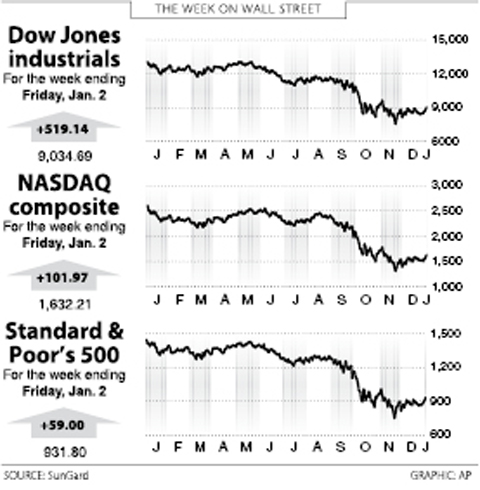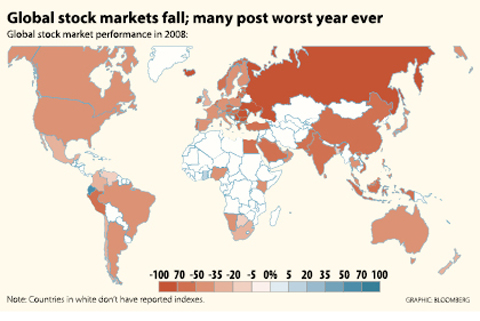US stocks may have started the New Year with a bang, but experts see major headwinds for the market as the new administration of US president-elect Barack Obama moves rapidly to eject the economy from prolonged recession.
All three key stock indices shot up at least 6 percent in the week to Friday as investors banked on Obama, who takes over from US President George W. Bush on Jan. 20, to push ahead with a mammoth plan to stimulate growth in the world’s largest economy.
“Mr Obama’s stimulus plan will be a major focal point for the market in January,” Patrick O’Hare of Briefing.com said.

“No one knows for certain right now what it will end up looking like, but one thing is certain at this point: it will be big in terms of its cost,” he said.
Obama is scheduled to meet lawmakers tomorrow to finalize an infrastructure-based stimulus package that media reports say ranges from US$850 billion to US$1 trillion in a bid to pump prime the US economy, reeling from its worst crisis since the Great Depression.
Nigel Gault, chief economist at IHS Global Insight, cautioned that any stimulus plan based on spending to boost infrastructure would take time to revitalize the economy.

“But how quickly can the funds actually be spent?” he asked. “Infrastructure spending is a key part of the package, and it cannot be turned on and off like a faucet. We assume that the funds will take much longer than two years to spend out.”
But Gault said that combined with the Federal Reserve’s vigorous easing of interest rates, the stimulus package should help stabilize the economy in the second half of this year and promote some recovery during next year.
The Dow Jones Industrial Average surged a hefty 6.09 percent for the holiday-shortened week to finish Friday at 9,034.69, its highest close since Nov. 5.
The tech-studded NASDAQ leapt 6.66 percent to 1,632.21 and the broad-market Standard & Poor’s 500 index advanced 6.75 percent to 931.80 for the week.
Experts cautioned that the advances of the key indices came amid very low trading volume as many investors were still on holiday.
Only twice in the past seven sessions has trading volume on the New York Stock Exchange exceeded 1 billion shares.
Trading in the week ahead could be dictated by a series of new economic data to be released, including last month’s vehicle and retail sales figures and the widely watched employment report for the month, experts said. Economists expect that the US shed jobs for the 12th straight month last month while investors will closely watch to see if holiday retail sales were as poor as some retailers had suggested.
The number of companies to announce their quarterly earnings results will also start to pick up the coming week.
“Next week’s indicators will constitute yet another stark reminder of how forces in the economy reached maximum negative amplitude at the end of 2008,” analysts at Global Insight said in a report.
The bond market, which had greatly benefited from the financial and economic uncertainty, fell the past week.
The 10-year Treasury bond yield rose to 2.416 percent from 2.137 percent the previous week and that on the 30-year Treasury bond was up to 2.815 percent from 2.613 percent.
Bond yields and prices move in opposite directions.

Authorities have detained three former Taiwan Semiconductor Manufacturing Co (TMSC, 台積電) employees on suspicion of compromising classified technology used in making 2-nanometer chips, the Taiwan High Prosecutors’ Office said yesterday. Prosecutors are holding a former TSMC engineer surnamed Chen (陳) and two recently sacked TSMC engineers, including one person surnamed Wu (吳) in detention with restricted communication, following an investigation launched on July 25, a statement said. The announcement came a day after Nikkei Asia reported on the technology theft in an exclusive story, saying TSMC had fired two workers for contravening data rules on advanced chipmaking technology. Two-nanometer wafers are the most

NEW GEAR: On top of the new Tien Kung IV air defense missiles, the military is expected to place orders for a new combat vehicle next year for delivery in 2028 Mass production of Tien Kung IV (Sky Bow IV) missiles is expected to start next year, with plans to order 122 pods, the Ministry of National Defense’s (MND) latest list of regulated military material showed. The document said that the armed forces would obtain 46 pods of the air defense missiles next year and 76 pods the year after that. The Tien Kung IV is designed to intercept cruise missiles and ballistic missiles to an altitude of 70km, compared with the 60km maximum altitude achieved by the Missile Segment Enhancement variant of PAC-3 systems. A defense source said yesterday that the number of

A bipartisan group of US representatives have introduced a draft US-Taiwan Defense Innovation Partnership bill, aimed at accelerating defense technology collaboration between Taiwan and the US in response to ongoing aggression by the Chinese Communist Party (CCP). The bill was introduced by US representatives Zach Nunn and Jill Tokuda, with US House Select Committee on the Chinese Communist Party Chairman John Moolenaar and US Representative Ashley Hinson joining as original cosponsors, a news release issued by Tokuda’s office on Thursday said. The draft bill “directs the US Department of Defense to work directly with Taiwan’s Ministry of National Defense through their respective

Tsunami waves were possible in three areas of Kamchatka in Russia’s Far East, the Russian Ministry for Emergency Services said yesterday after a magnitude 7.0 earthquake hit the nearby Kuril Islands. “The expected wave heights are low, but you must still move away from the shore,” the ministry said on the Telegram messaging app, after the latest seismic activity in the area. However, the Pacific Tsunami Warning System in Hawaii said there was no tsunami warning after the quake. The Russian tsunami alert was later canceled. Overnight, the Krasheninnikov volcano in Kamchatka erupted for the first time in 600 years, Russia’s RIA